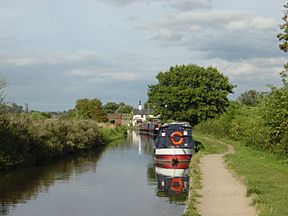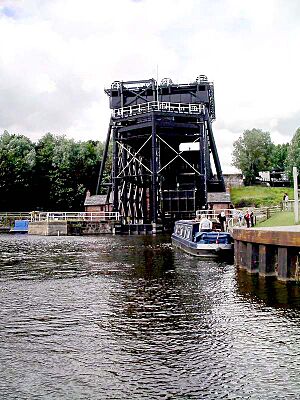Trent and Mersey Canal facts for kids
Quick facts for kids Trent and Mersey Canal |
|
|---|---|

The Trent and Mersey Canal near Branston Water Park
|
|
| Specifications | |
| Locks | 76 |
| Status | Open |
| Navigation authority | Canal and River Trust |
| History | |
| Principal engineer | James Brindley |
| Other engineer(s) | Hugh Henshall |
| Date of act | 1766 |
| Date of first use | 1777 |
| Geography | |
| Start point | River Trent, Derwent Mouth |
| End point | River Mersey (via Bridgewater Canal) |
| Connects to | |
The Trent and Mersey Canal is a long waterway in central England. It stretches for about 93+1⁄2-mile (150 km) through Derbyshire, Staffordshire, and Cheshire. This canal is mostly "narrow," meaning it's built for smaller boats.
Most of the canal is just wide enough for a single narrowboat. These boats are usually 7 feet (2.1 m) wide and 72 feet (22 m) long. But in some parts, like near Burton upon Trent and Middlewich, the canal is "wide."
Wide sections of the canal can fit boats that are 14 feet (4.3 m) wide. This means two narrowboats can travel side-by-side. The canal uses special gates called locks to help boats move up and down hills.
Contents
Building the Trent and Mersey Canal
The Trent and Mersey Canal, often called the T&M, was built to connect two big rivers. It links the River Trent in Derbyshire to the River Mersey in Cheshire. This created an important water route across England.
It connected major port cities like Hull (on the Trent) and Liverpool (on the Mersey). The canal joins the Bridgewater Canal at Preston Brook to reach the Mersey.
Early Ideas for a Waterway
People first thought about building a canal between the Mersey and Trent rivers in 1755. However, nothing happened with the idea back then. In 1760, Lord Gower, a local businessman, made a plan for the canal.
If his plan had been built, it would have been one of England's first modern canals. James Brindley, a famous canal engineer, worked on this project. He later became known for building many canals across England.
Josiah Wedgwood's Involvement
In 1761, Josiah Wedgwood, a famous pottery maker, became very interested in the canal. His business, Wedgwood pottery, was in Stoke-on-Trent. He needed a safe way to transport his delicate pots.
Roads were bumpy, and pots often broke during travel. A canal near his factory would offer fast and safe transport. Wedgwood's first idea was just to connect his potteries to the River Mersey.
Choosing the Canal's Path
There were many arguments about where the canal should go. Coal sellers in Liverpool worried that a canal would bring in cheaper coal from Cheshire. This would hurt their business.
Owners of the River Weaver also weren't happy, as the canal would run very close to their river. Another plan was made that completely left out the pottery towns. Wedgwood was very surprised by this.
With help from friends, Wedgwood managed to get his plan to Parliament. In 1766, the plan for the "Grand Trunk" canal was approved by Parliament. On July 26th, Josiah Wedgwood dug the first bit of soil to start building.
Building Challenges and Completion
James Brindley was hired as the main engineer for the project. Six years before the canal fully opened, Wedgwood built a factory village called Etruria. It was right next to the canal in Stoke-on-Trent.
By 1771, much of the canal was built towards Preston Brook. The biggest challenge was digging a tunnel through a hill at Kidsgrove. Until the tunnel was finished in 1777, pots had to be carried over the hill.
The entire Trent and Mersey Canal was finished in 1777. It included over 70 locks and five tunnels. The main office for the canal company was in Stone.
The Grand Cross Plan
The Trent and Mersey Canal was part of a bigger idea by James Brindley called the "Grand Cross." This plan aimed to connect England's four main rivers: the Trent, Mersey, Severn, and Thames.
The T&M Canal formed the northwestern and northeastern parts of this cross. It also created the central meeting point between Great Haywood and Fradley Junctions. Other canals completed the rest of the cross, linking to the Severn and Thames.
Cool Features of the Canal
Anderton Boat Lift
In Cheshire, you can find the amazing Anderton Boat Lift. This Victorian-era lift connects the T&M Canal to the River Weaver below. It lowers boats fifty feet!
The lift was closed for twenty years but was fixed and reopened in 2002. For a while, it was the only working boat lift in the United Kingdom. Later, the Falkirk Wheel was built in Scotland.
Harecastle Tunnel
Another big feature is the Harecastle Tunnel, near Kidsgrove. There are actually two tunnels here. The first one, built by Brindley, was 2,880 yards (2,630 m) long. Boats were moved through it by men pushing against the roof with their feet. This was hard and slow work.
So, a civil engineer named Thomas Telford built a second, wider tunnel next to it. This new tunnel, 2,926-yard-long (2,676 m), opened in 1827 and had a towpath. The Brindley tunnel is now closed because of ground problems. However, the Telford Tunnel is still used today. It's the fourth-longest canal tunnel in the United Kingdom.
Flyover Junction
Just north of Harecastle Tunnel is a special 'flyover' junction. This is where the Hall Green Branch leaves the main T&M canal. The branch crosses over the main line using a bridge called Poole Lock aqueduct.
This allows boats to travel north to join the Macclesfield Canal at Hall Green. It's a clever way to keep boats moving smoothly without getting in each other's way.
Stoke-on-Trent Section
The canal goes right through the city of Stoke-on-Trent. Here, it connects with the Caldon Canal. The canal was a key part of the 1986 Stoke-on-Trent Garden Festival.
In the 1990s, the path next to the canal, called the towpath, was improved. It is now part of the National Cycle Network (Route 5), perfect for cycling and walking.
Exploring the Canal Route
The Trent and Mersey Canal can be thought of in two main parts. The Harecastle Tunnel divides the northern and southern sections.
Northern Trent and Mersey Canal
The northern end of the canal meets the Bridgewater Canal inside Preston Brook Tunnel. From here, you can go towards Runcorn or Manchester.
Traveling south from the Bridgewater Canal, the T&M goes through Preston Brook Tunnel. It also passes through two smaller tunnels: Saltersford and Barnton. These tunnels have one-way traffic, alternating directions every half-hour.
Near Northwich, the canal connects to the River Weaver at the Anderton Boat Lift. Further south, you reach Middlewich. Here, the short Wardle Canal leads to the Middlewich Branch of the Shropshire Union Canal. This branch can take you to Chester or Llangollen.
South of Middlewich, the canal climbs out of the Cheshire Plain. It does this using a series of locks known as 'Heartbreak Hill' or the 'Cheshire Locks'. Many of these locks used to have two chambers, but not all are still in use.
This section leads to the Hall Green Branch, which connects to the Macclesfield Canal. Boaters can use the Macclesfield Canal to complete the 'Cheshire Ring' route.
Dutton Hollow Breach in 2012
In September 2012, a serious break happened at Dutton Hollow. This part of the canal is near Preston Brook. The break cost about £2.1 million to fix.
The canal was closed between Dutton Hollow and Middlewich Big Lock 75. It officially reopened on May 2, 2013.
Southern Trent and Mersey Canal
After passing through the Harecastle Tunnel, the canal enters the edge of Stoke-on-Trent. Soon, it's in the middle of the city, reaching Etruria. This is where it meets the Caldon Canal.
Leaving Etruria, the canal goes into the countryside. It follows the upper part of the River Trent. The next town you reach is Stone.
Further on, the canal arrives at Great Haywood Junction. Here, it connects with the Staffordshire and Worcestershire Canal. This canal goes south to the River Severn at Stourport-on-Severn. This link connects the Mersey and Severn rivers.
The canal then makes a sharp turn, changing its direction from southeast to northeast. This turn leads towards Nottingham. Very close by is Fradley Junction. Here, the canal meets a part of the Coventry Canal.
The Coventry Canal can lead to Birmingham or to Coventry. From Coventry, you can connect to the Oxford Canal and then to the River Thames. This links the Trent and Mersey Canal to the southern part of England's canal system.
The canal then heads directly to its end point. It passes through Burton upon Trent and Mercia Marina at Findern. This is the largest inland waterway marina in the United Kingdom.
Finally, the canal reaches Shardlow and then Derwent Mouth. From Derwent Mouth, you can travel a short distance on the River Trent to Trentlock. This is a four-way junction with other canals and rivers. The Trent River is navigable all the way to its mouth at Trent Falls on the Humber Estuary.
Images for kids
-
Hall Green Branch crosses the T&M at Poole Aqueduct
-
Hardings Wood Junction with the Hall Green Branch







